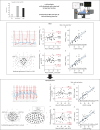Pulmonary artery wedge pressure and left ventricular end-diastolic pressure during exercise in patients with dyspnoea
- PMID: 37670852
- PMCID: PMC10475984
- DOI: 10.1183/23120541.00750-2022
Pulmonary artery wedge pressure and left ventricular end-diastolic pressure during exercise in patients with dyspnoea
Abstract
Background: Pulmonary artery wedge pressure (PAWP) during exercise, as a surrogate for left ventricular (LV) end-diastolic pressure (EDP), is used to diagnose heart failure with preserved ejection fraction (HFpEF). However, LVEDP is the gold standard to assess LV filling, end-diastolic PAWP (PAWPED) is supposed to coincide with LVEDP and mean PAWP throughout the cardiac cycle (PAWPM) better reflects the haemodynamic load imposed on the pulmonary circulation. The objective of the present study was to determine precision and accuracy of PAWP estimates for LVEDP during exercise, as well as the rate of agreement between these measures.
Methods: 46 individuals underwent simultaneous right and left heart catheterisation, at rest and during exercise, to confirm/exclude HFpEF. We evaluated: linear regression between LVEDP and PAWP, Bland-Altman graphs, and the rate of concordance of dichotomised LVEDP and PAWP ≥ or < diagnostic thresholds for HFpEF.
Results: At peak exercise, PAWPM and LVEDP, as well as PAWPED and LVEDP, were fairly correlated (R2>0.69, p<0.01), with minimal bias (+2 and 0 mmHg respectively) but large limits of agreement (±11 mmHg). 89% of individuals had concordant PAWP and LVEDP ≥ or <25 mmHg (Cohen's κ=0.64). Individuals with either LVEDP or PAWPM ≥25 mmHg showed a PAWPM increase relative to cardiac output (CO) changes (PAWPM/CO slope) >2 mmHg·L-1·min-1.
Conclusions: During exercise, PAWP is accurate but not precise for the estimation of LVEDP. Despite a good rate of concordance, these two measures might occasionally disagree.
Copyright ©The authors 2023.
Conflict of interest statement
Conflict of interest: None declared.
Figures



References
LinkOut - more resources
Full Text Sources
Miscellaneous
